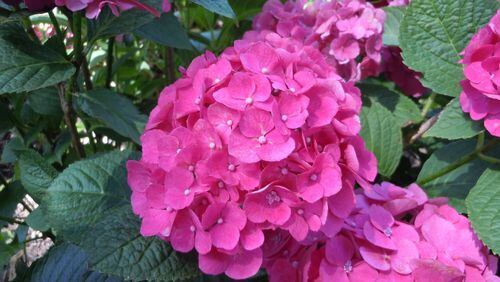Q: My hydrangeas are more pink than usual this year. Do you know why?Helen Rice, email
A: I could suggest theories, but I'm not sure they hold water. Hydrangea flower color is determined by the amount of aluminum present in the flower petals. More aluminum in the soil equals a blue-er bloom. Perhaps last year's drought damaged the shrub roots so not as much aluminum was absorbed this spring. Perhaps the March freeze damaged the top flower buds and the secondary flower buds were not able to absorb aluminum as they normally would in most years. This may be one of those garden mysteries that has no answer. You can promote blue flowers in the future by adding a couple of tablespoons of aluminum sulfate to a gallon of water and pouring it around your hydrangeas.
Q: If you apply pre-emergent in August, can you overseed fescue in October?Clark Connelly, email
A: Sure you can, but you won't get any weed control from the pre-emergent you put down in August. Most winter weeds germinate in October, just like your fescue does. In your situation, perfect your seed planting, fertilizing and watering techniques to help the healthy fescue control weeds. This is better than putting out a pre-emergent to control weeds in a thinly growing fescue lawn that needs reseeding.
Q: When is it best to fertilize my summer blooming perennials?Stella Marie Russell, email
A: If you use a liquid fertilizer, fertilize one time at planting, once six weeks later, and another time six weeks after that. Of course, a timed-release granular fertilizer, like Osmocote, can last up to six months before it stops supplying nutrients to your plants. The latter is more expensive, but you never have to rack your memory trying to recall when you last fed your flowers.
Q:Please evaluate pine straw versus chip mulch in attracting snakes to an area.Deborah Rosser, email
A: Whenever you have a nuisance creature in your landscape, the first question to ask is this: "Why is it here and not somewhere else?" Snakes come to an area where they can find things to eat (like crickets, toads and worms) or where they can find shelter in a stack of firewood or a pile of stones. I suppose a thick layer of pine straw would offer more shelter and food sources than a layer of chips would. But I would not be surprised to see a wandering snake in either material.
Q: I'm looking for a plant with the name "Walter" to plant in my garden to honor my great-grandfather. Any suggestions?Kathy Aprile, email
A: I have an evergreen Walter viburnum, Viburnum obovatum, and a Walter dogwood, Cornus walteri, in my landscape. The viburnum is 4 feet high and 4 feet wide, but it can grow much larger. The dogwood is a small 20-foot-tall tree. Both have been trouble-free for several years. They may be hard to find locally, but I'll bet you could find them online for planting this fall.






